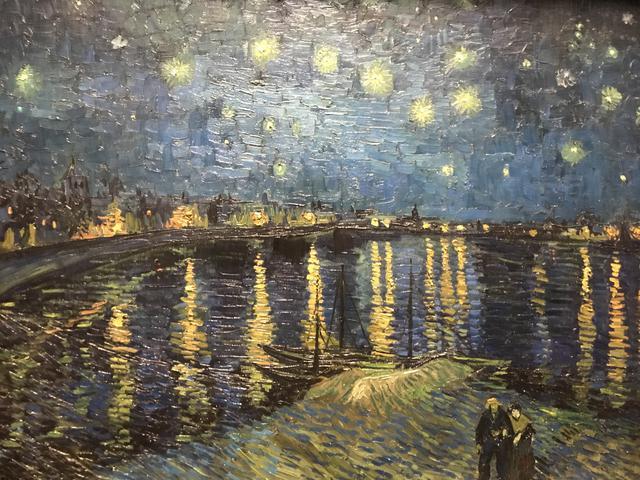Starry Night of the Rhône

The Starry Night over the Rhône is a breathtaking painting by the renowned artist Vincent van Gogh, created in September 1888 during his time in Arles, France. This masterpiece showcases Van Gogh's fascination with capturing the effects of light in the night sky, a theme that he explored in several of his works. The painting depicts a tranquil scene along the Rhône River, with the night sky illuminated by stars and the reflection of artificial lighting on the water. Van Gogh's use of bold brushstrokes and vibrant colors brings the night to life, creating a sense of movement and energy within the stillness of the scene.
Unlike Van Gogh's more famous work, The Starry Night, which portrays a swirling night sky over a sleepy village, The Starry Night over the Rhône offers a moment of calm and serenity. The artist's attention to detail is evident in the way he captures the shimmering reflections on the water and the twinkling stars above. This painting serves as a precursor to The Starry Night, as Van Gogh continued to explore the theme of the night sky and its effects in his later works.
Van Gogh's fascination with the night sky stemmed from his desire to capture the beauty and mystery of the natural world. The Starry Night over the Rhône is a testament to his ability to translate his emotions and observations onto canvas, creating a visual symphony of light and color. The painting invites viewers to immerse themselves in the peaceful ambiance of the night, allowing them to experience the magic of the evening through Van Gogh's eyes.
As visitors gaze upon The Starry Night over the Rhône, they are transported to a moment of tranquility and contemplation. The painting serves as a reminder of Van Gogh's profound connection to nature and his relentless pursuit of capturing its essence in his art. Whether viewed in person at the Musée d'Orsay in Paris or through the pages of an art book, this masterpiece continues to inspire awe and admiration for its timeless beauty and emotional depth.
In conclusion, The Starry Night over the Rhône is a testament to Vincent van Gogh's artistic genius and his ability to convey the beauty of the night sky with unparalleled skill and passion. This painting stands as a testament to the artist's enduring legacy and his unwavering commitment to capturing the essence of the natural world in all its glory. Visitors to Paris and art enthusiasts alike are encouraged to experience this masterpiece firsthand and witness the magic of Van Gogh's vision come to life on canvas.
© ChatGPT 3.5
It was exhibited at the Orsay in 1889 at the annual exhibition of the Société des Artistes Indépendants in Paris, together with The Lilies.
An important detail that helps to understand a little about Van Gogh's technique is that for him representing color was something very important. In fact, in many of his letters to his brother Theo, he often described objects as if they were colors.
Van Gogh headed to Arles because, according to what he told his brother Theo, “I find it almost impossible to work in Paris, unless you have a refuge where you can regain your peace of mind and composure” and although he momentarily achieved calm , it was in this place where his mental health ended up deteriorating.
It is interesting to note that The Starry Night in the Rhône and The Starry Night were painted just a month apart, which, although it denotes a similar style and theme, a change is noted more on a personal level that is reflected in the second painting. This may also denote the mental deterioration that Van Gogh was experiencing and which obviously reflects his feelings at that time. A much more violent sensation is clearly noticeable in Starry Night than in this work.